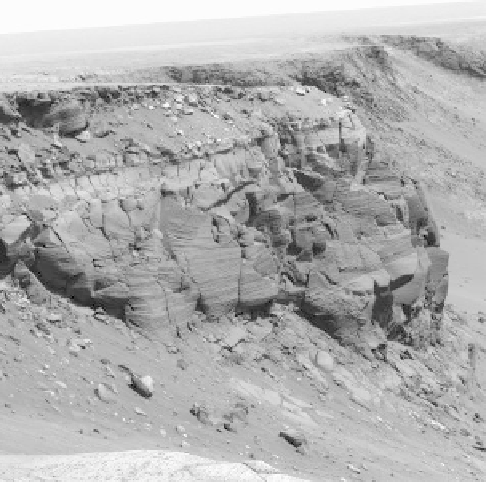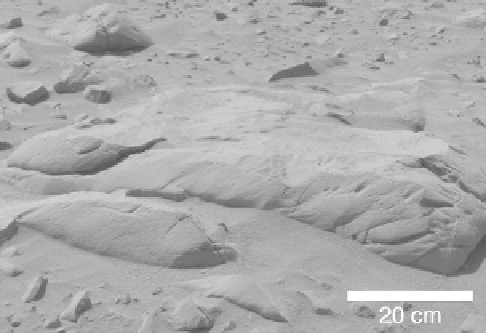Geology Reference
In-Depth Information
Figure 7.34. Ventifacts are wind-abraded rocks, such as these
imaged by the rover Spirit in Gusev crater; the basaltic rocks show
elongated grooves that were sand-blasted by winds coming from the
right side of the image (NASA Spirit Pancam image).
Figure 7.32. An outcrop imaged by the Opportunity rover on the rim
of Victoria, an 800m impact crater. The outcrop is about 12m high
and exhibits cross-bedding that is thought to re
ect paleo-sand dune
deposits (NASA PIA10210).
Figure 7.33. An oblique view of the Medusa Fossae Formation in the
Eumenides Dorsum region, showing yardangs, the elongate
streamlined-shaped hills cut into the formation (ESA HRSC image).
Figure 7.35. Bright (high-albedo) wind streaks in the Cerberus
region; these and similar features indicate the prevailing wind
direction at the time of their formation (in this case, winds blew from
the upper right to the lower left). The area shown is 156 km by
184 km (NASA Viking Orbiter 545A54).
atmosphere
(Fig. 3.33)
, sand grains are accelerated to high
speeds and are effective agents of abrasion.
Contrasting albedo patterns that appear, disappear, or
change their size, shape, or orientation are very common
and are called variable features
(Fig. 7.35)
. These
include dark (low-albedo) wind streaks, bright (high-
albedo) wind streaks, and dust devil tracks left by the
passage of dust devils, noted above. The albedo contrasts
are thought to result from removal or deposition of wind-
blown particles. Thus, keeping in mind the general corre-
lation with particle size, high albedo can be indicative of
fine-grained material such as dust, whereas lower albedo






